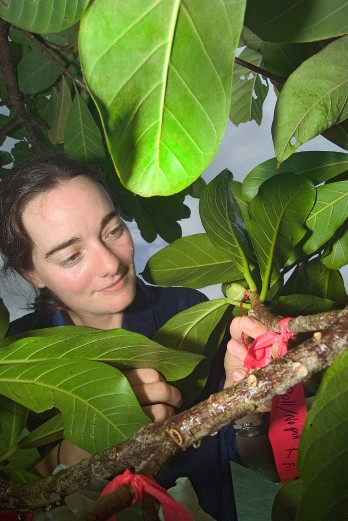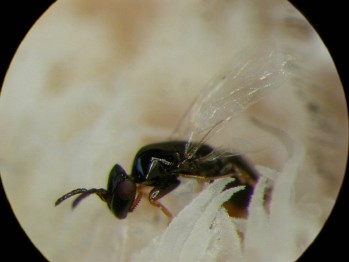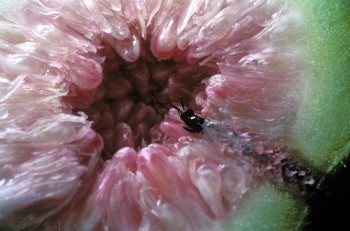RESEARCH SPOTLIGHT
Trees strike back when wasps' efforts are fruitless, biologist finds

Charlotte Jandr examines a flowering fig from her boat on the Panama Canal. See larger image
Avoiding aggressive spider monkeys and menacing crocodiles in the Panama rain forest are part of the job, says a Cornell graduate student who studies how figs and fig wasps have evolved together.
To collect samples, Charlotte Jandér zips around in a motorized dinghy on the Panama Canal that surrounds the 1,500-hectare Barro Colorado Island, which is used for research by the Smithsonian Institute Research Station and where Jandér has also been a predoctoral fellow since 2005.
Many of the figs she studies hang from trees over the water, and she must stand on the little boat's edges for hours at a time, reaching for fruit to mark them. In addition to fig-eating spider monkeys that try to chase her away, a lone crocodile will often surface, whether curious or hungry, near her boat.
"I don't want to fall in with a crocodile in the water about 10 meters away," says Jandér, a former Swedish medical doctor who left the profession in 2001 to study canopy ecology in Costa Rica before enrolling in Cornell's Department of Neurobiology and Behavior in 2004.
Since becoming a biologist, Jandér has focused on the mutually beneficial relationship between figs and fig wasps: Fig wasps lay their eggs inside the fruit where the wasp larvae can safely develop, and in return, the wasps pollinate the figs.
Specifically, Jandér has tried to answer the question of what happens if the symbiotic relationship fails: What if a wasp lays its eggs but fails to pollinate the fig?

Female fig wasp (Tetrapus americanus) is about to enter a flowering fig (Ficus maxima). See larger image
The trees get even by dropping those figs to the ground, killing the baby wasps inside, she reported with co-author Edward Allen Herre, a staff scientist at the Smithsonian institute in Panama, in the Proceedings of the Royal Society B: Biological Sciences (published online in January).
The findings suggest that when one species in a mutually beneficial relationship fails to hold up its end of the bargain, sanctions may be a necessary part of maintaining the relationship.
"We want to know what forces maintain this 80 million-year-old mutualism between figs and their wasp pollinators," Jandér says. "What prevents the wasps from cheating and reaping the benefits of the relationship without paying the costs?" More than 700 species each of fig trees and wasps have co-evolved in the tropics worldwide, with each fig tree species having its own species of pollinating wasp. Jandér worked on six fig tree-fig wasp pairs for the study. Some wasp species passively carry pollen that sticks to their bodies, while others actively collect pollen in special pouches.

Closeup view of a fig wasp; once inside the fig, the wasp will pollinate and lay her eggs in the flowers that line the inside of the fig. See larger image
The researchers found that in passively pollinated pairings, the tree almost never aborted its fruit, and the wasp always carried pollen. However, the researchers found that in actively pollinated pairings, where the wasp needs to expend energy to collect pollen, the tree dumped the fruit and killed the offspring when the wasps did not carry pollen.
The researchers also found that among the actively pollinated fig species, pollen-free wasps were much more common when the trees had weak sanctions.
"Sanctions seem to be a necessary force in keeping this and other mutually beneficial relationships on track when being part of a mutualism is costly," says Jandér. "In our study, we saw less cheating when sanctions were stronger. Similar results have been found among human societies and social insects. It is very appealing to think that the same general principles could help maintain cooperation both within and among species."

Detail of a flowering fig tree. See larger image
The research described here is part of Jandér's Ph.D. thesis. She is currently doing molecular work to see if the cheating trait in wasps is passed from mother wasps to offspring through genes and plans to finish her Ph.D. in 2011. Though crocodiles and spider monkeys will continue to add an element of risk to her future work, at least they keep things interesting, she says.